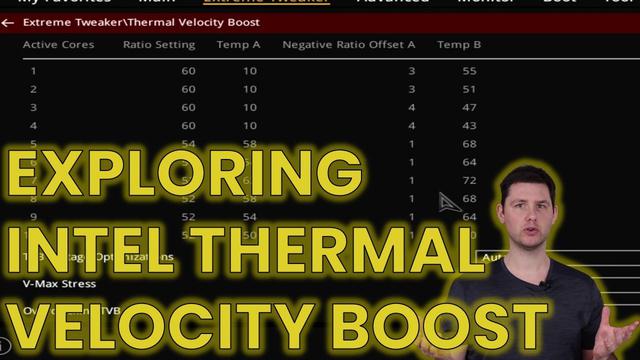Intel Thermal Velocity Boost is a feature available in certain mobile and desktop CPUs from Intel. The typical CPU has a standard clock speed and turbo boost speed. However, CPUs with Intel’s Thermal Velocity Boost have two additional boost speeds. Also known as Intel TVB, the feature’s available on Intel’s 10th Generation Core i9 desktop chips, 10th Gen i9, i7 and i5 mobile CPUs and the Intel Xeon W-1200 lineup.
Intel Thermal Velocity Boost allows these CPUs to hit even higher boost speeds than its typical all-core turbo boost. CPUs with Thermal Velocity Boost add a Single-Core Thermal Velocity Boost and an All-Core Thermal Velocity Boost.
Intel Thermal Velocity Boost vs Turbo Boost
In addition to its two Thermal Velocity Boost speed and its all-core boost, an Intel CPU can use Intel Turbo Boost Max Technology. CPUs with Turbo Boost Max have 1 or 2 favored CPU cores, which are identified as being the fastest of the bunch via binning. Workloads from lightly or single-threaded applications are pushed to these favored core(s) for better performance. These additional frequencies are called Turbo Boost 2.0 (a single-core boost) and Turbo Boost 3.0 (a dual-core boost).

This means that besides its stock clock speed and all-core boost, an Intel CPU can have four additional speeds. Let’s break them down.
Turbo Boost 2.0 is a single-core boost available if the CPU’s running under its power, current and temperature specifications.
Turbo Boost Max 3.0 speed applies to two favored cores. It’s only achievable if the CPU is running below its power, current and temperature specifications.
Single-Core Thermal Velocity Boost takes the faster of the two favored CPU cores to a speed higher than what’s achieved with Turbo Boost Max 3.0.
For 10th Gen desktop CPUs, this is only doable if the CPU is running under 70 degrees Celsius (158 degrees Fahrenheit) and if the CPU is working beneath its power, current and temperature specifications. For 10th Gen mobile CPUs, the temperature threshold is 65 degrees Celsius (149 degrees Fahrenheit).
All-Core Thermal Velocity Boost refers to the speed achievable if every core is active and the CPU is operating under its respective temperature threshold (70 degrees Celsius for desktop chips, 65 degrees Celsius for mobile ones).
To see how these frequencies can range, check out the specs for the Intel Core i9-10900K and Intel Core i9-10900 below. You can also see how more chips stack up in our CPU Benchmarks hierarchy.
| Turbo Boost 3.0 Max (2 cores) | All-Core Thermal Velocity Boost | Base Clock Speed | Turbo Boost (all cores) | Turbo Boost 2.0 (one core) | Turbo Boost 3.0 Max (2 cores) | |
|---|---|---|---|---|---|---|
| Intel Core i9-10900 | 5.2 GHz | 4.6 GHz | 2.8 GHz | 4.6 GHz | 5.0 GHz | 5.1 GHz |
| Intel Core i9-10900K | 5.3 GHz | 4.9 GHz | 3.7 GHz | 4.8 GHz | 5.1 GHz | 5.2 GHz |
This article is part of the Tom's Hardware Glossary.




